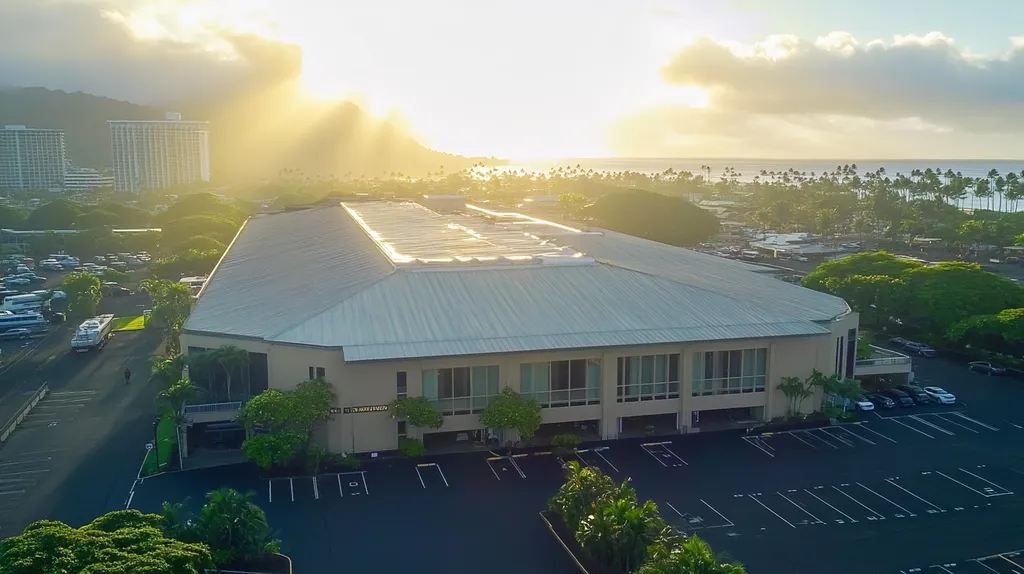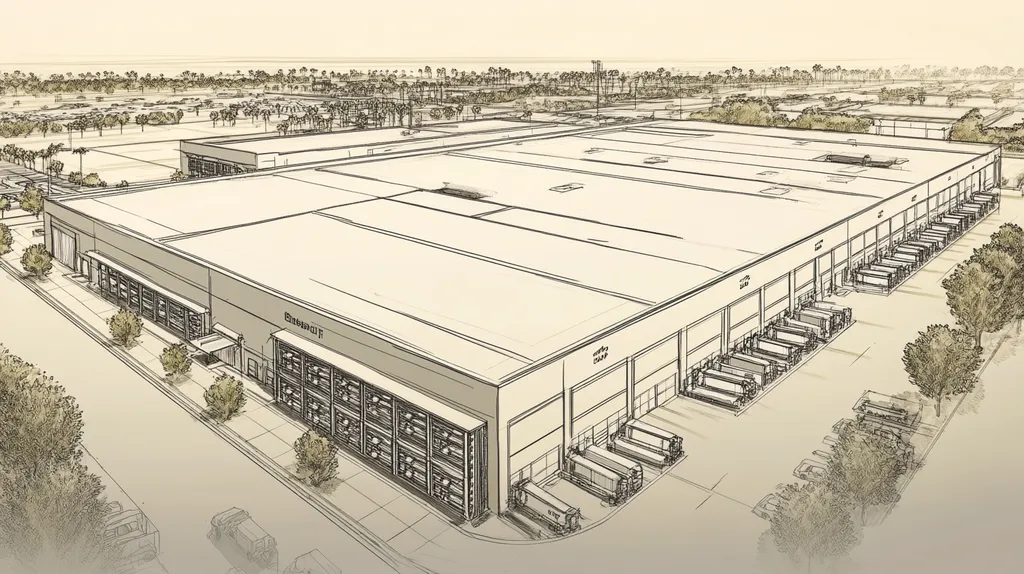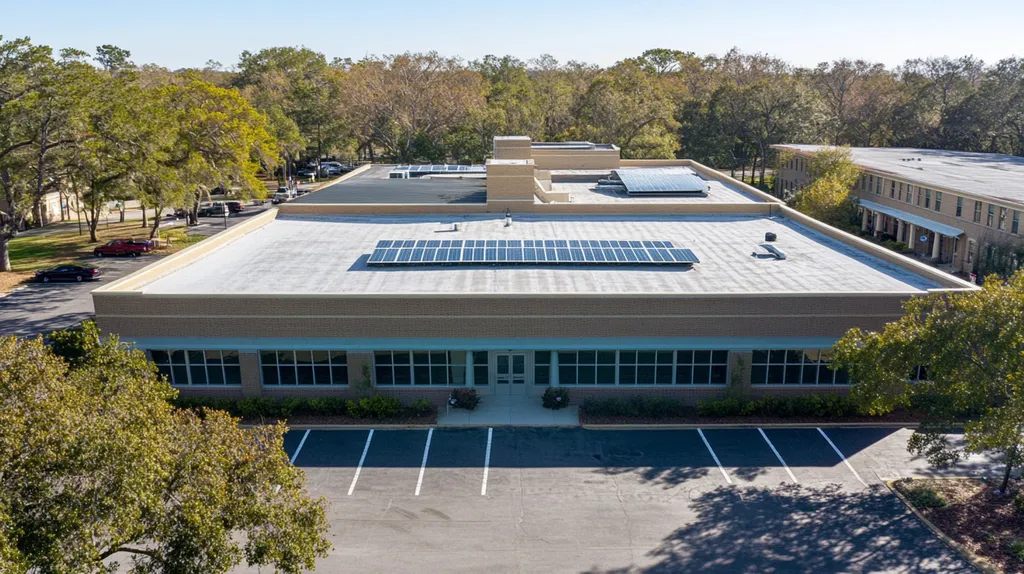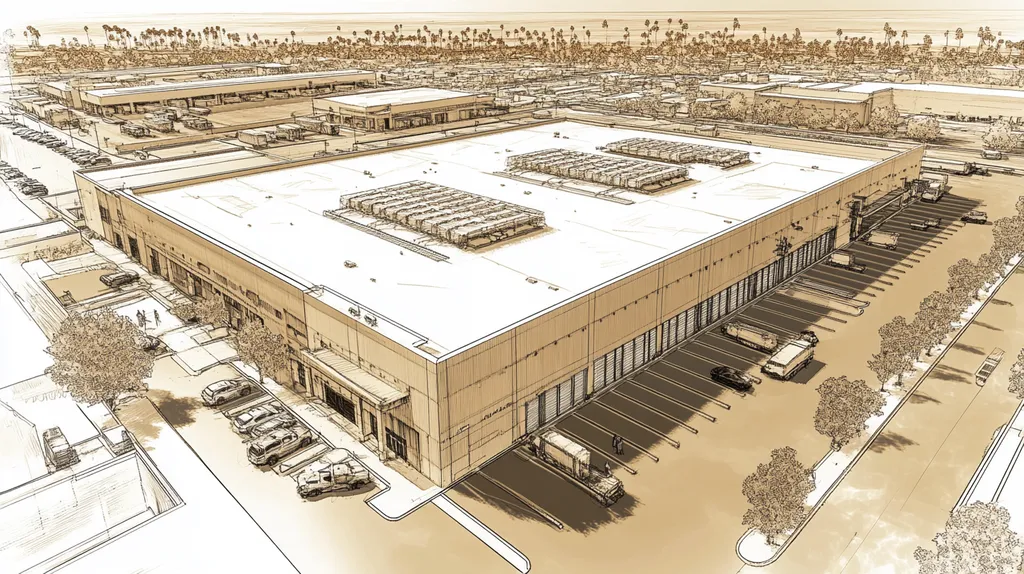Extreme weather events caused over $145 billion in commercial property damage during 2021, with roofing failures accounting for 30% of these losses. Yet many facilities continue relying on conventional roofing equipment and materials ill-equipped for increasingly severe conditions.
This systemic vulnerability stems from outdated industry practices that prioritize initial cost savings over long-term resilience. From inadequate material selection to poor maintenance protocols, multiple factors contribute to catastrophic roof failures during storms.
This analysis examines why traditional approaches to extreme weather protection are failing and explores evidence-based alternatives that better safeguard commercial properties.
SECTION 1: CURRENT PRACTICES
As severe weather becomes increasingly common, the demand for robust commercial roofing solutions intensifies. In 2021, extreme weather contributed to over $100 billion in damages across the United States, underscoring the importance of effective roofing strategies. Despite these alarming statistics, many property owners and facility managers continue to rely on traditional roofing methods that may inadequately protect their properties. This section examines the prevalent materials, standard installation techniques, and existing maintenance practices that often overlook the harsh realities of extreme weather impacts.
Common Roofing Materials in Use
Common roofing materials for commercial structures include EPDM, TPO, PVC, and built-up roofing. While these materials are often chosen for their cost-effectiveness, their performance during extreme weather events can be questionable. For example, EPDM is appreciated for its durability but may falter in the face of hurricane-force winds and heavy snowfalls.
Facilities frequently opt for single-ply membranes, drawn by their straightforward installation. However, this convenience can mask significant vulnerabilities; TPO, while energy-efficient, can degrade under intense UV exposure, leading to premature roof failure. Such risks are crucial considerations for property owners anticipating extreme weather scenarios.
Moreover, though built-up roofing is regarded for its water penetration resistance, it often fails to account for the thermal expansion and contraction caused by drastic temperature variations. Thus, selecting appropriate roofing materials necessitates a careful evaluation of the specific climate and environmental challenges faced by each property.
Standard Installation Methods
Current installation practices often prioritize rapid execution and low costs rather than ensuring long-term resilience. Typically, roofing systems are installed without adequate preparation for extreme weather conditions. For instance, mechanically attaching roofing membranes can lead to catastrophic failures in high winds if not performed meticulously.
Additionally, many installations lack proper drainage systems, which can result in water pooling and a heightened risk of leaks and ongoing deterioration. Inadequate roof slopes can exacerbate issues, particularly in areas susceptible to heavy rains or snow accumulation.
Moreover, poor inspection routines and non-compliance with manufacturer guidelines can create weaknesses in the roofing system. Effective installation demands skilled technicians who can proactively recognize and mitigate risks associated with extreme weather events.
Maintenance Protocols
Routine maintenance is essential for prolonging the life of commercial roofs, yet it is frequently neglected by property managers. Current maintenance protocols often focus solely on routine cleaning and debris removal, overlooking the specific challenges posed by extreme weather. For instance, a simple inspection may miss dislodged flashing or compromised seals, which can lead to substantial damage.
Furthermore, proactive strategies such as applying protective coatings or reinforcing seams are rarely part of standard practice. Implementing a comprehensive maintenance plan that includes thorough inspections after extreme weather events can help identify potential vulnerabilities before they escalate.
Neglecting to invest in proper maintenance can lead to escalating repair and replacement costs over time. Adopting a strategic maintenance approach is critical for enhancing resilience against future extreme weather challenges, making it an indispensable part of commercial roofing management.
SECTION 2: SYSTEMIC ISSUES
The increasing intensity and frequency of extreme weather events place commercial roofs at significant risk. Properties located in regions prone to hurricanes endure heightened threats from high winds and hail, endangering structural integrity. Ignoring these vulnerabilities not only compromises safety but can also lead to expensive repairs and legal liabilities. This section explores the systemic challenges that arise from current roofing practices in response to these severe weather conditions.
Vulnerabilities to High Winds and Hail
High winds and hail exert considerable strain on commercial roofing systems. Many traditional roofs lack sufficient reinforcement, making them prone to uplift during storms. Research indicates that roofs without proper attachment mechanisms can experience wind uplift failures at speeds as low as 60 mph.
This vulnerability often leads to extensive internal damage, as water infiltrates and compromises insulation and electrical systems. Accordingly, repair costs can increase dramatically when roofs are unable to withstand these harsh elements. Property owners find themselves caught in a cycle of frequent inspections and repairs, diverting vital resources from other necessary areas.
Incorporating resilient design features and materials, such as reinforced membranes and enhanced fastening systems, can substantially reduce these risks. However, the industry’s focus on minimizing costs often results in roofs being left exposed to potential extreme weather events.
Ultimately, a proactive approach to addressing vulnerabilities is crucial, favoring long-lasting solutions over temporary fixes to ensure roof stability and performance.
Limitations in Water Resistance and Drainage
Inadequate water resistance and drainage systems present significant threats to commercial roofs, especially during heavy rainfall. Many existing roofs depend on outdated drainage designs that struggle to manage large volumes of water, leading to ponding and leaks. Studies suggest that even minor water build-up can result in considerable structural damage over time.
Consequently, many properties endure expensive water damage related to these limitations, particularly those situated in flood-prone areas. This reality necessitates a reassessment of drainage strategies to avoid severe financial repercussions.
Innovative drainage solutions, such as tapered insulation and advanced waterproof membranes, are frequently overlooked yet can help minimize water pooling. By implementing these systems, property managers can enhance overall roof resilience and significantly reduce future maintenance needs and expenses.
In conclusion, prioritizing thorough evaluations of water resistance and drainage capabilities is essential for effective and sustainable roofing strategies.
Thermal Shock and UV Degradation
Thermal shock and UV degradation pose serious threats that commercial roofs must adequately address. Rapid temperature fluctuations can cause roofing materials to expand and contract, resulting in cracks and accelerated wear. Ignoring these challenges risks long-term structural integrity issues.
Furthermore, UV exposure significantly deteriorates roofing materials, especially those unprotected against intense sunlight. Roofs situated in sunny climates are particularly susceptible to early signs of wear and tear if they lack protective coatings or are made from UV-resistant materials.
The financial implications of thermal shock and UV degradation are considerable. Property managers often face unexpected replacement costs, in addition to declining energy efficiency as insulation properties diminish. Selecting materials designed to endure extreme temperature variations and UV exposure leads to meaningful savings over time.
Thus, property owners must give priority to durable materials that can withstand these systemic issues to ensure lasting roof performance.
SECTION 3: MISSED OPPORTUNITIES
As the frequency and severity of extreme weather events continue to rise, commercial and industrial property owners face an urgent need to address vulnerabilities in their roofing systems. Unfortunately, many overlook advanced roofing technologies that could provide essential protection. Neglecting these innovations, skipping regular inspections, and dismissing energy-efficient roofing options often results in catastrophic failures and substantial financial losses. This section highlights critical areas where property owners consistently miss opportunities to enhance their roof performance.
Overlooking Advanced Roofing Technologies
Property owners frequently rely on outdated roofing systems that are ill-equipped to handle severe weather. Modern materials like thermoplastic polyolefin (TPO) and modified bitumen demonstrate superior resistance to extreme temperatures and high winds. By failing to consider these advanced options, property owners forfeit the chance to significantly bolster their roofs’ durability.
In addition, features such as reflective surfaces and advanced waterproof membranes enhance a roof’s resilience during storms. Many conventional systems fail to match this level of performance, compromising both protection and energy efficiency. Investing in these innovations is not merely prudent; it is essential for long-term sustainability.
Moreover, the absence of smart roofing sensors, which can monitor potential issues in real time, is a missed opportunity in facility management strategies. These tools provide invaluable early warnings, enabling proactive maintenance before minor issues escalate into costly repairs. Ignoring such technologies risks not only rapid repair needs but also the potential for larger, more expensive replacements.
Ultimately, neglecting to adopt advanced roofing solutions undermines a property’s safety and diminishes its marketability. Staying informed about and integrating new technologies should be a priority for responsible property management.
Neglecting Regular Inspections and Repairs
Regular roof inspections are often viewed as an unnecessary expense, yet they are critical for preventing significant problems down the line. Research shows that 80% of roof failures occur due to a lack of maintenance. Property owners who neglect these assessments often miss early warning signs that could prevent minor issues from becoming major complications.
Many roofing systems develop hidden problems that can manifest during extreme weather, leading to alarming and expensive consequences. Routine inspections can identify issues such as cracks, splits, or leaks, allowing for timely interventions that save thousands in repair and replacement costs. A proactive maintenance approach ensures roofs are operationally sound when they need to be the most.
Relying solely on post-storm evaluations is insufficient; consistent inspections are vital for maintaining structural integrity, particularly for roofs facing intense weather. Delaying inspections can be akin to ignoring an impending disaster.
For forward-thinking organizations, regular inspections should form the backbone of any maintenance strategy. The long-term benefits far outweigh the initial costs, safeguarding investments both in the short and long run.
Ignoring Energy-Efficient Solutions
In today’s competitive commercial landscape, energy efficiency is a crucial element that should not be overlooked. Ignoring energy-efficient roofing options can lead to inflated utility costs and diminished occupant comfort. Roofs designed with energy efficiency in mind reflect heat, which helps lower air conditioning demands and reduces energy bills.
Evidence increasingly shows that energy-efficient roofs can enhance a building’s overall value. Properties equipped with ENERGY STAR-rated roofing materials are more likely to experience higher occupancy rates. During the hottest summer months, a roof’s capacity to improve insulation and reflectivity can drastically influence a building’s energy consumption.
Investing in energy-efficient options also aligns with sustainability goals, enhancing a company’s reputation in an increasingly eco-conscious marketplace. Neglecting this area may result in lost competitive edges, making properties less appealing to prospective tenants.
By embracing energy-efficient roofing systems, property owners not only support environmental goals but can also enjoy immediate financial benefits that increase a property’s overall marketability. Dismissing these opportunities may represent a significant long-term oversight.
SECTION 4: ROOT CAUSES
The increasing prevalence of extreme weather events demands robust and reliable roofing systems. However, many commercial roofs suffer catastrophic failures during storms, leading to expensive repairs and significant operational downtime. Alarmingly, statistics indicate that improperly equipped roofs account for 30% of damage claims during such weather phenomena. This section delves into the core root causes behind these failures, focusing on shortcomings in material selection, design flaws, and non-compliance with updated industry standards.
Inadequate Material Selection Criteria
A key issue in commercial roofing failures is the lack of stringent criteria for material selection. Many property owners emphasize cost savings over quality and durability. This often results in the use of inferior materials, such as standard asphalt or low-grade membranes, which can falter in extreme conditions like hurricane winds.
The consequences of choosing subpar materials are severe; studies indicate that roofs made from low-quality components can suffer a lifespan reduction of up to 50%. This leads to frequent repairs and disruptions that can significantly impact business operations and profitability.
Manufacturers may also prioritize short-term sales over long-term performance, underplaying the importance of selecting robust materials. The absence of rigorous standards for material selection can leave many roofs ill-prepared for severe weather challenges.
To combat this issue, industry stakeholders must advocate for stricter material selection guidelines that prioritize resilience over upfront cost. This proactive strategy will enhance the durability and effectiveness of roofing systems, safeguarding properties in the long term.
Poor Design and Structural Weaknesses
Poor architectural design represents a major factor in why commercial roofs fail under extreme weather conditions. Many designs lack the structural integrity necessary to withstand high winds, heavy rainfall, or snow accumulation. Implementing designs that consider local climatic challenges is crucial to roof longevity.
For example, flat roof designs may lead to inadequate drainage, resulting in water pooling that can weaken roofing materials over time. Such conditions inevitably lead to leaks and failures, particularly during intense storms.
Additionally, incorrect load calculations can jeopardize the structural elements supporting roofing systems. Buildings in areas prone to hurricanes specifically need designs that account for designated wind loads; neglecting this factor can have catastrophic results.
To minimize these risks, property owners should collaborate with experienced architects and engineers who specialize in weather-resistant design. Investing in effective architectural practices not only reduces liability but also leads to lower long-term maintenance costs.
Lack of Compliance with Updated Standards
A significant contributor to commercial roofing failures is the inadequate adherence to updated industry standards. Many roofing companies continue to rely on outdated guidelines that do not reflect the latest advancements in materials and technology. This oversight renders roofs ill-equipped to tackle today’s weather challenges.
For instance, standards for wind resistance and waterproofing have been significantly revised in recent years. Yet, outdated systems still remain installed, leaving properties vulnerable to the elements. Failing to comply with updated codes can also invite legal and financial repercussions for property owners.
Moreover, the absence of regular inspections and retrofitting aggravates the situation. Without consistent evaluations, existing weaknesses can go unnoticed until significant damage occurs.
Focusing on compliance with the latest standards empowers property owners to better safeguard their investments. Regularly updating roofing practices and technologies ensures systems are equipped to endure the rigors of extreme weather, ultimately enhancing overall roof reliability.
DATA DRIVEN EVIDENCE
In an era where extreme weather events increasingly threaten commercial properties, assessing their impact on roofing systems is crucial. The National Oceanic and Atmospheric Administration (NOAA) reports that damage from such events exceeds $300 billion annually. Property owners must confront the inadequacies of conventional roofing solutions, which often fail to withstand these harsh conditions. This section delves into key studies and data that shed light on material performance, historical failures, and cost-effective roofing strategies amidst extreme weather challenges.
Historical Weather Event Impact Studies
Examining historical events reveals alarming trends in roofing failures during extreme weather situations. Hurricane Katrina in 2005 exposed significant vulnerabilities within many commercial roofing systems, which were unable to handle the harsh winds and heavy rainfall. Such failures underscore the urgent need for property owners to reassess their roofing choices.
Similarly, data collected from the Midwest during severe winter storms indicated that inadequately insulated roofs faced issues like ice damming and even structural collapse. These instances highlight the critical need for updated roofing solutions that can withstand extreme weather. A historical perspective on these storms can guide better decision-making today.
Moreover, insurance claim statistics consistently indicate that roofs equipped with conventional materials suffer more damage during extreme weather. By analyzing these historical impacts, stakeholders can advocate for construction practices that prioritize durability and resilience in the face of increasingly turbulent weather conditions.
Material Performance Data in Extreme Conditions
The performance of roofing materials under extreme conditions is vital for ensuring long-term stability. For instance, during intense heat waves, certain materials degrade faster than anticipated. In contrast, polyurethane foam roofs have exhibited superior thermal resistance compared to traditional membrane systems.
Research shows that advanced roof coatings can provide an effective protective layer that extends the lifespan of roofing systems in harsh climates. Additionally, EPDM and TPO membranes often become brittle when exposed to prolonged ultraviolet radiation, leading to leaks and costly repairs.
Evidence from the International Roofing Institute strongly supports that modern materials outperform older ones in providing effective protection against severe conditions. Transitioning to these innovative materials can significantly mitigate risks and foster sustainability in roofing practices.
Cost-Benefit Analysis of Different Roofing Systems
Conducting a thorough cost-benefit analysis of various roofing systems yields significant insights. While conventional systems may appear less expensive initially, the long-term expenses associated with repairs and replacements can be staggering. Studies indicate that modified bitumen roofs may be cheaper upfront but often incur higher maintenance costs over their lifespan.
Conversely, investing in high-performance roofs, although they may require a larger upfront investment, usually leads to lower total lifecycle costs. Reflective roofing materials, for example, significantly reduce energy bills, effectively offsetting initial installation costs.
Furthermore, advanced roofing systems often outlast their traditional counterparts, translating to fewer replacements and thus decreasing the overall financial burden on property owners. Transitioning to resilient roofing options not only supports environmental sustainability but also makes robust economic sense. A proactive approach to roofing choices can yield substantial returns and enhance property value.
SECTION 6: ALTERNATIVE SOLUTIONS
As extreme weather conditions escalate in frequency and severity, the pressing need for effective commercial roofing solutions has never been clearer. Roofs must endure not only rain and snow but also high winds, hail, and drastic temperature fluctuations. Conventional roofing systems are often inadequate, resulting in expensive repairs and operational interruptions. Property owners must, therefore, consider alternative options that promise greater durability and resilience against these mounting challenges. This section highlights innovative roofing solutions better suited to tackle extreme weather conditions.
Adopting EPDM and Built-Up Roofing Systems
Ethylene Propylene Diene Monomer (EPDM) and built-up roofing systems offer strong alternatives to conventional roofing materials. EPDM is recognized for its exceptional durability and impressive resistance to ultraviolet rays, making it ideal for various climates. This synthetic rubber has shown a commendable long-term performance even under severe weather conditions.
Built-up roofing consists of multiple layers of roofing felt and bitumen, providing remarkable watertight capabilities. This layered assembly enhances protection against severe weather impacts, significantly minimizing the risk of leaks and resultant water damage. Such systems have established a reliable track record in commercial installations and can greatly extend the lifespan of a roof.
Investing in EPDM or built-up roofing systems can translate into reduced maintenance costs and fewer repairs for property owners. These solutions are designed for longevity, delivering financial savings while bolstering a building’s structural integrity. Embracing resilient roofing options is vital for ensuring commercial properties withstand future extreme weather.
Implementing Impact-Resistant and Metal Roofing
Impact-resistant roofing systems, including specially designed shingles and metal roofing, deliver superior protection against hail and flying debris. These materials are engineered to endure significant impacts without compromising their structural integrity. With severe weather on the rise, demand for such roofing solutions continues to increase in the industrial sector.
Metal roofing presents numerous benefits, including lightweight construction and exceptional longevity. Its reflective design contributes to improved energy efficiency, subsequently lowering cooling costs. The durability of metal roofs enables them to perform effectively even in extreme conditions, thereby reducing the frequency of necessary repairs.
By adopting impact-resistant and metal roofing solutions, property owners can anticipate fewer complications stemming from storm damage. This proactive approach not only safeguards the structure but also enhances the building’s overall market value. Making the transition to robust, resilient roofing is a strategic decision for navigating today’s climate-focused landscape.
Integrating Reflective and Green Roof Technologies
Integrating reflective and green roof technologies can significantly enhance a building’s resilience to climate challenges. Reflective roofs are often coated with materials designed to minimize heat absorption, which directly lowers energy costs. This feature is particularly important in alleviating the urban heat island effect in regions prone to extreme temperatures.
Conversely, green roofs provide dual advantages: they deliver insulation and mitigate stormwater runoff. By absorbing rainwater, green roofs help reduce the likelihood of flooding and alleviate pressure on drainage systems during heavy downpours. This sustainable approach not only benefits the environment but also enhances the aesthetic appeal of the building.
Incorporating reflective and green technologies largely supports environmental initiatives, showcasing a company’s commitment to sustainability. Increasingly, property owners are exploring these options to improve their buildings’ performance against extreme weather threats. The long-term benefits of these investments far outweigh any short-term costs associated with their implementation.
Moving Forward
The data is clear: conventional roofing equipment and materials are failing to protect commercial properties against increasingly extreme weather, resulting in over $145 billion in annual damages.
Property owners can no longer afford to rely on outdated approaches when superior alternatives like EPDM systems, impact-resistant materials, and smart monitoring technologies offer proven protection.
The cost of inaction continues to rise, with insurance claims from weather-related roof failures increasing 65% since 2015.
By implementing advanced materials, maintaining rigorous inspection protocols, and embracing energy-efficient solutions, facilities can significantly reduce their vulnerability while improving long-term operational sustainability.
The choice is stark: adapt roofing strategies now or face catastrophic failures when extreme weather strikes.
FREQUENTLY ASKED QUESTIONS
Q. What common roofing materials are used for commercial roofs?
A. Common materials include EPDM, TPO, PVC, and built-up roofing. While they are often chosen for cost-effectiveness, their performance during extreme weather varies, with some showing vulnerabilities to high winds and UV exposure. Understanding the strengths and weaknesses of these materials is crucial for effective selection based on climate challenges.
Q. How do conventional practices fail commercial roofs during extreme weather?
A. Conventional practices often prioritize cost and speed over durability, failing to adequately prepare roofs for extreme weather conditions. Issues such as poor installation techniques and inadequate drainage systems exacerbate vulnerabilities, putting roofs at risk during storms and leading to potential failures that necessitate costly repairs.
Q. What are the systemic issues affecting industrial roofs?
A. Systemic issues include insufficient reinforcement against high winds and hail, outdated drainage designs, and improper material selection. These factors heighten the risk of roof failures and lead to expensive water damage, necessitating a comprehensive evaluation of existing systems to enhance their resilience.
Q. Why are advanced roofing technologies often overlooked?
A. Property owners often fail to adopt advanced roofing technologies due to reliance on outdated systems or a lack of awareness. Innovations in materials and designs enhance durability and offer better protection against extreme weather, yet many continue to prioritize short-term savings over long-term resilience and cost efficiency.
Q. What root causes lead to roofing failures in severe weather?
A. Major root causes of roofing failures include inadequate material selection, poor architectural design, and a lack of compliance with updated industry standards. These issues leave roofs vulnerable to extreme weather, often leading to significant repairs and operational disruptions for property owners.
Q. How has data informed roofing practices during extreme weather?
A. Data from historical weather events indicates that conventional roofing systems often fail under extreme conditions, leading to significant financial losses. Studies analyzing material performance and failure costs underscore the need for reinforcing the roofing strategies employed by property owners to ensure stability and durability.
Q. What innovative solutions can enhance the resilience of commercial roofs?
A. Innovative solutions include adopting EPDM and impact-resistant roofing systems, as well as implementing reflective and green technologies. These options not only improve durability against extreme weather but also enhance energy efficiency and sustainability, making them attractive for modern property owners.










